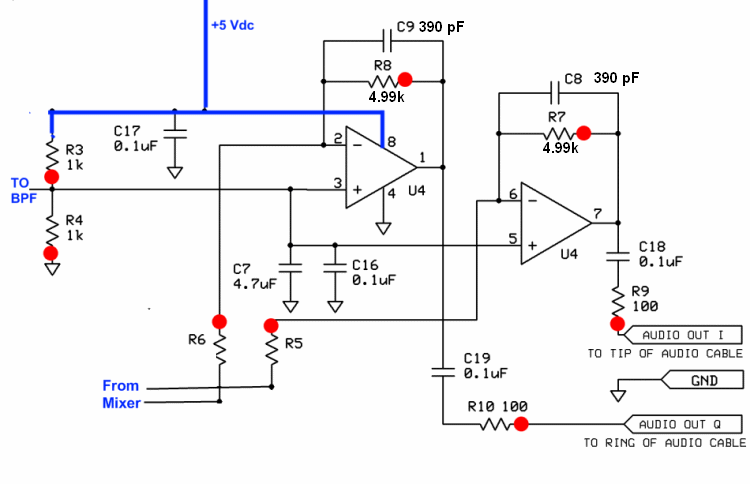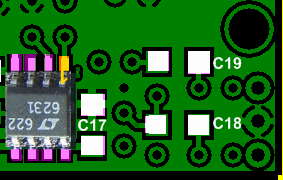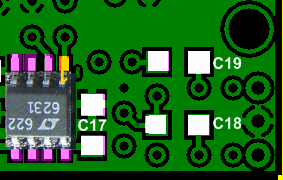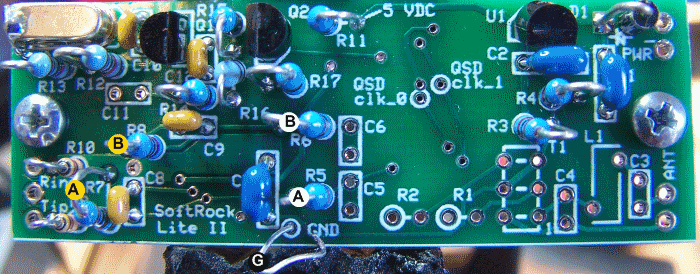Operational Amplifiers Introduction
Theory of Operation
The low-level In-Phase (I) and Quadrature (Q) IF signals from the Mixer are sampled over capacitors C5 and C6 (in the Mixer stage).
The Opamp amplifies the I and Q signals by about 500 times.
Operational Amplifiers Schematic
(Resistor testpoints (hairpin, top, or left-hand lead), as physically installed on the board, are marked in the schematic with red dots)
(Click for Full Schematic)
(above schematic has clickable areas that can be used for navigation)
(go directly to build notes)Operational Amplifiers Bill of Materials
Stage Bill of Materials
(resistor images and color codes courtesy of WIlfried, DL5SWB's R-Color Code program)
| Check | Count | Component | Marking | Category |
|---|---|---|---|---|
| ❏ | 2 | 1 k 1/4W 1% | br-blk-blk-br-br
 | 1/4W |
| ❏ | 2 | 4.99 k 1/4W 1% | y-w-w-br-br
 | 1/4W |
| ❏ | 2 | 100 1/6W 5% | br-blk-br-gld
 | 1/6W |
| ❏ | 2 | 390 pF 5% | 391
 | Ceramic |
| ❏ | 1 | 4.7 uF 10% 16V X7R RAD | 475
 | Ceramic |
| ❏ | 2 | band-specific | misc | |
| ❏ | 1 | LT6231 dual op-amp | LT6231
 | SOIC-8 |
Band Specific Items for 160m Band
| Check | Designation | Component | Marking | Category | Orientation | Notes | Circuit |
|---|---|---|---|---|---|---|---|
| ❏ | R05 | 49.9 ohm 1% | yel-wht-wht-gld-brn
 | 1/4W | E-W | Operational Amplifiers | |
| ❏ | R06 | 49.9 ohm 1% | yel-wht-wht-gld-brn
 | 1/4W | E-W | Operational Amplifiers |
Band Specific Items for 80m Band
| Check | Designation | Component | Marking | Category | Orientation | Notes | Circuit |
|---|---|---|---|---|---|---|---|
| ❏ | R05 | 49.9 ohm 1% | yel-wht-wht-gld-brn
 | 1/4W | E-W | Operational Amplifiers | |
| ❏ | R06 | 49.9 ohm 1% | yel-wht-wht-gld-brn
 | 1/4W | E-W | Operational Amplifiers |
Band Specific Items for 40m Band
| Check | Designation | Component | Marking | Category | Orientation | Notes | Circuit |
|---|---|---|---|---|---|---|---|
| ❏ | R05 | 49.9 ohm 1% | yel-wht-wht-gld-brn
 | 1/4W | E-W | Operational Amplifiers | |
| ❏ | R06 | 49.9 ohm 1% | yel-wht-wht-gld-brn
 | 1/4W | E-W | Operational Amplifiers |
Band Specific Items for 30m Band
| Check | Designation | Component | Marking | Category | Orientation | Notes | Circuit |
|---|---|---|---|---|---|---|---|
| ❏ | R05 | 10 ohm 1/4W 1% | br-blk-blk-gld-br
 | 1/4W | E-W | Operational Amplifiers | |
| ❏ | R06 | 10 ohm 1/4W 1% | br-blk-blk-gld-br
 | 1/4W | E-W | Operational Amplifiers |
Band Specific Items for 20m Band
| Check | Designation | Component | Marking | Category | Orientation | Notes | Circuit |
|---|---|---|---|---|---|---|---|
| ❏ | R05 | 10 ohm 1/4W 1% | br-blk-blk-gld-br
 | 1/4W | E-W | Operational Amplifiers | |
| ❏ | R06 | 10 ohm 1/4W 1% | br-blk-blk-gld-br
 | 1/4W | E-W | Operational Amplifiers |
Operational Amplifiers Summary Build Notes
- Install OpAmp
- Install band-specific components
- Install remaining components
- Test the Stage
Operational Amplifiers Detailed Build Notes
Bottom of the Board

Install OpAmp
Install the LT6231 operational amplifier to the bottomside of the board.
See hints on installing SMT ICs.
- Orient U4 on its pads so that the pin 1 corner of the IC matches the small “1" (it also looks like a “0”) mark in the copper on the bottom side of the board. In general, pin 1 of an SOIC packaged IC is in the lower left corner of the package when the printing on the package top reads upright, from left to right.
- Tack-solder one corner pin of U4 and reheat the tacked pin as necessary to line up U4 on its pads properly.
- Double-check the orientation of U4 and the line up of the IC on its pads with magnification and good lighting. You do NOT want to install U4 oriented incorrectly. If all is well, carefully solder the rest of the leads to their pads.

| Check | Designation | Component | Marking | Category | Orientation | Notes |
|---|---|---|---|---|---|---|
| ❏ | U4 | LT6231 dual op-amp | LT6231
 | SOIC-8 |  | Take ESD precautions |
Top of the Board

Install band-specific components
Install the band-specific capacitors and resistors.
See band-specific chart for values
See hints on orienting and installing resistors.
See hints on identifying and installing ceramic caps.
| Check | Designation | Component | Marking | Category | Orientation | Notes | ||||||||||||||||||
|---|---|---|---|---|---|---|---|---|---|---|---|---|---|---|---|---|---|---|---|---|---|---|---|---|
| ❏ | R05 | band-specific |
| misc | E-W | |||||||||||||||||||
| ❏ | R06 | band-specific |
| misc | E-W |
Install remaining components
See hints on orienting and installing resistors.
See hints on identifying and installing ceramic caps.
| Check | Designation | Component | Marking | Category | Orientation | Notes |
|---|---|---|---|---|---|---|
| ❏ | C08 | 390 pF 5% | 391
 | Ceramic | ||
| ❏ | C09 | 390 pF 5% | 391
 | Ceramic | ||
| ❏ | C07 | 4.7 uF 10% 16V X7R RAD | 475
 | Ceramic | ||
| ❏ | R07 | 4.99 k 1/4W 1% | y-w-w-br-br
 | 1/4W | S-N | |
| ❏ | R03 | 1 k 1/4W 1% | br-blk-blk-br-br
 | 1/4W | W-E | |
| ❏ | R08 | 4.99 k 1/4W 1% | y-w-w-br-br
 | 1/4W | E-W | |
| ❏ | R04 | 1 k 1/4W 1% | br-blk-blk-br-br
 | 1/4W | W-E | |
| ❏ | R09 | 100 1/6W 5% | br-blk-br-gld
 | 1/6W | E-W | |
| ❏ | R10 | 100 1/6W 5% | br-blk-br-gld
 | 1/6W | E-W |
Operational Amplifiers Testing
Warning
Test Setup
Take appropriate ESD precautions in these tests, since you will be working around the sensitive OpAmp ICVisual Check
Test Setup
Using very good lighting and magnification, carefully inspect the solder joints to identify bridges, cold joints, or poor contacts.
Pay especial attention to the joints on the OpAmp IC pins. If necessary, touch up the joints with your iron and/or some flux. Wick up any excess.
Current Draw
Test Setup
- In each test, the ammeter must be placed in series between the positive lead of the power source and the board's positive power-in "+" terminal.
- In one test there is also a 100 ohm resistor in the series "chain" as well.
- in the second test, the setup is the same except that the current-liminting resistor is removed
Apply 12 Vdc to the board for this test
Test Measurements
| Testpoint | Units | Nominal Value | Author's | Yours |
|---|---|---|---|---|
| With 100 ohm current-limiting resistor | mA | < 30 | 26.6 | _______ |
| Without current limiting resistor | mA | < 30 | 26.9 | _______ |
Voltage Tests
Test Setup
Measure the voltages with respect to ground for each of the pins of U4. Tage care to measure at the actual IC pin rather than the pad, so as to ensure you are measuring the PIN voltage
expected voltages are indicated in the table below:
- 5 V (range of 4.5 - 5.4)
- 2.5 V (approx 50% of the 5V rail value)

Test Measurements
| Testpoint | Units | Nominal Value | Author's | Yours |
|---|---|---|---|---|
| Pin 1 | Vdc | 2.5 | 2.46 | _______ |
| Pin 2 | Vdc | 2.5 | 2.46 | _______ |
| Pin 3 | Vdc | 2.5 | 2.46 | _______ |
| Pin 4 | Vdc | 0 | 0 | _______ |
| Pin 5 | Vdc | 2.5 | 2.46 | _______ |
| Pin 6 | Vdc | 2.5 | 2.46 | _______ |
| Pin 7 | Vdc | 2.5 | 2.46 | _______ |
| Pin 8 | Vdc | 5 | 4.94 | _______ |
Functional Test
Test Setup
You will test the DC gain of each of the op-amps by connecting resistors RB from each op-amp inverting input to circuit ground. Introducing the "bridging" resistor RB will result in a test current equal to 2.5 / Rt which will be balanced by the current fed back from each op-amp's output through each feedback resistor, RF (i.e., R7 or R8). Each op-amp output will increase in voltage by 2.5 * RF/ RB from the nominal DC level of 2.5 volts.
The value of the "bridging" resistor (RB) is 10 kΩ:
Test the First OpAmp
Power up the circuit and measure the voltage at pin 1 of the op-amp (hairpin of R8). It should be ~2.5 Vdc- Power off and use clip leads to connect RB between the hairpin of R6 and circuit ground. (This provides an input resistance(Ri) of 10 kΩ
- Power up and measure the output voltage at the hairpin of the feedback resistor R8. You should get:, with RB=10 kΩ and R8=4.99 kΩ: ~3.75 Vdc.
- Remove RB and the output voltage at R8 should go back to ~2.5 Vdc.
Test the Second OpAmp
Power up the circuit and measure the voltage at pin 7 of the op-amp (hairpin of R7). It should be ~2.5 Vdc- Power off and use clip leads to connect RB between the hairpin of R5 and circuit ground. (This provides an input resistance(Ri) of 10 kΩ
- Power up and measure the output voltage at the hairpin of the feedback resistor R7. You should get, with RB=10 kΩ and R7=4.99 kΩ: ~3.75 Vdc.
- Remove RB and the output voltage at R7 should go back to ~2.5 Vdc.
The diagram below shows the test points. The yellow dots show the output voltage measurement points. The white points show the bridging resistor connection points (connect the bridging resistor RB between the ground and a white point). To measure the voltage at yellow point "A", use white point "A" for the bridge; same with points "B".
An Excel spreadsheet with a calculator for this test is available for you to plug in your bridging resistor ohms (Rt) and your pin 1 or pin 7 normal voltages (Ebias) and predict the expected voltage when bridged (Eout).
 Functional Test"
Functional Test"
Test Measurements
| Testpoint | Units | Nominal Value | Author's | Yours |
|---|---|---|---|---|
| R7 (yellow "A")- unbridged | Vdc | 2.5 | 2.48 | _______ |
| R8 (yellow "B") - unbridged | Vdc | 2.5 | 2.46 | _______ |
| R7 (yellow "A") bridging white "A" to ground | Vdc | 3.75 | 3.72 | _______ |
| R8 (yellow "B") bridging white "B" to ground | Vdc | 3.75 | 3.69 | _______ |

